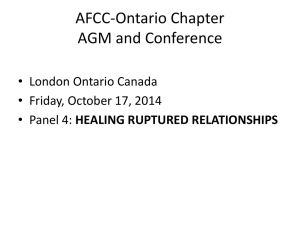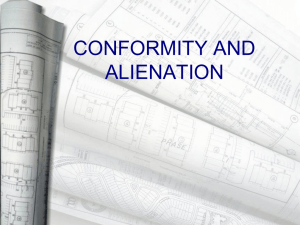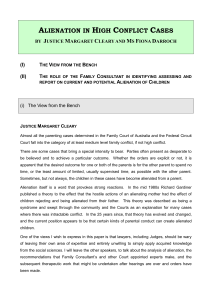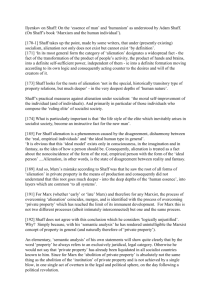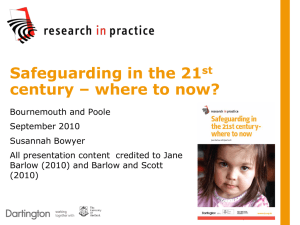Alienated Children
advertisement
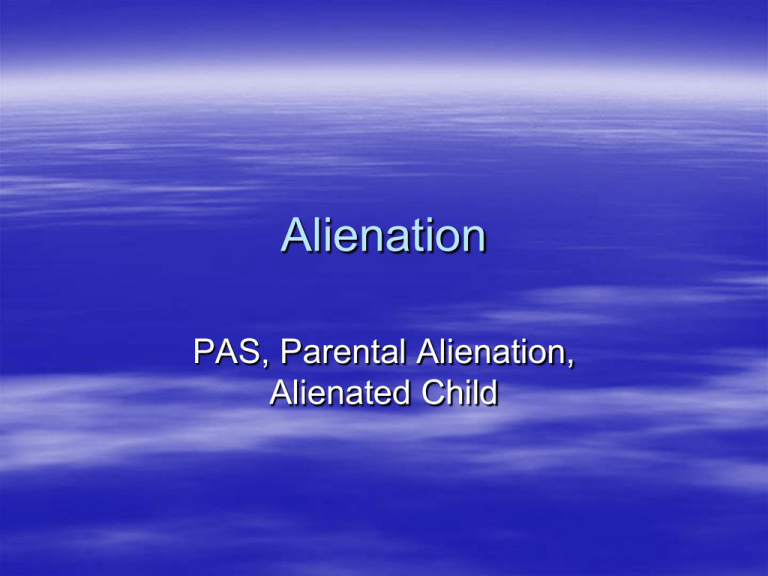
Alienation PAS, Parental Alienation, Alienated Child Parent Alienation Syndrome Pathological Alignment (Wallerstein and Kelly, 1980) Parent Alienation Syndrome (PAS), Richard Gardner – Reaction on child’s part to one parent – Preoccupation with depreciation and criticism of target parent – Denigration is not supported by history of the relationship, or is highly exaggerated response to minor weaknesses PAS (cont.) – Created in part by systematic, conscious programming – Created in part by subconcious factors of the alienating parent – Contributions from the child’s personality, temperament, maturity – Situational factors contribute Manifestations of PAS – – – – – – – – – Campaign of denigration Weak, frivolous rationalizations Lack of Ambivalence Independent thinking (child generated) Reflective support of aligned parent Absence of guilt Borrowed scenarios Generalization beyond the parent Re-writing of history Alienated Child Johnston and Kelly Reformulation – Parental preferences of the child exist on a continuum 1. No preference- equal, full attachment to each parent, with concurrent expressions of love. Preference may shift temporarily secondary to situational factors 2. Affinity- no difference in preference, but better “fit” to one parent due to a variety of factors, including age, gender, personality, interests. 3. Alignment- definitely expressed preference, but lacks rigidity of alienation. Generally form secondary to separation. Causes different reactions in each parent, either pleasure or anger and confusion. Alignments subside in absence of alienation 4. Estrangement- The rejection of a parent based on credible, rational reasons, i.e. abuse towards child, domestic violence in the home, insensitive parenting (poor parenting), neglect, drug and/or alcohol abuse, anger management issues, personality disorders, etc. 5. Alienation- basically the same behaviors as observed by Gardner. Always a pathological response and always caused, in part, by one parent. Pre-separation relationship not predictive of postseparation alienation. Children’s Relationships with Parents After Separation and Divorce Child’s Relationship Child prefers contact with One Parent Child prefers contact with both parents Positive relationsh ip with both Affinity With one parent Child rejects one parent (No Ambivalence) (ambivalence evident) Alliance with one parent Estrange ment from one parent Estrangem ent from one parent Realistic estrangement Alienated from one parent Realistic estrangement Pathological alienation Techniques of alienating parents – Deny existence of other parent – Passive-aggressive, indirect attacks on other parent – Use the child as middle man by talking negatively about other parent when an incident occurs – Blame other parent with little evidence – Ask the child “moral questions” that negatively reflect on parent Child Vulnerabilities – Child in black/white stage of moral development – Dependent child – Low self-esteem – Age related – Prior psychological problems – Insecure attachments – Enmeshed Normal reactions to divorce that include temporary alienation or preferences (Warshak, 2002) – Temporary adjustment reactions – Separation Anxiety – Temperamental issues related to the child, i.e. shyness, anxious, oppositional – Conflict avoidance – Role reversal and emotional support – Situation-specific reactions, i.e. new paramour, affinities – Parent-child partnerships, i.e. alignments Parent Alienation and Attachment Theory Benjamin Garber, 2004, Journal of Child Custody – Alienation presupposes a bond between parent and child – Attachment is dynamic and adaptive relationship specific to each care-giver and child – Child uses relationship to establish security – Attachments are not same, and offer different levels of security – The quality of attachment security is flexible, adaptive and caregiver specific – Early attachment does not predict later behavior when there have been intervening changes in parenting quality – Changes in parenting quality causes less adaptive behavior, changes to more sensitive parenting may increase infant attachment security – Internal Working Models accommodate new information from more varied sources as a child matures – New information about an individual is either consistent or inconsistent with the IWM of the child – If information is inconsistent it is either assimilated (disregarded, does not change the IWM) or accommodated (reshapes the IMW) – If accommodated information makes the child feel more secure, it is “Aligning” – If accommodated information makes the child feel less secure, it is “Alienating.” – In normal, healthy family, such information and accommodation help with safety and identification – New Information coming from the caregiver is accommodated by the child through self-reflection and may be aligning or alienating. Thus a given caregiver can affect the attachment relationship with their child by actions and words. – Information from outside parties can affect the IWM of the child, either to create greater security (alignment) or lesser security (alienation) – Coparent alignment is the healthy, mutually supportive dynamic of parents reinforcing the security of the attachments of their child with each parent – Coparent alienation occurs when a parent’s words or actions decrease the security of attachment of a child and the other parent. – Impact of accuracy of the message If the message is accurate, the change in the IWM and subsequent relationship is appropriate, i.e. if a parent reassures a child about a sensitive parent, their security (and alignment) is enhanced. Similarly, if a parent discusses safety issues about an abusive parent, the child’s “estrangement” (decreased security) is accurate. Inaccurate messages create multiple problems. An inaccurate endorsement of an insensitive, abusive parent creates a misalignment. Inaccurate denigration of a sensitive, appropriate parent causes “alienation.” Alienation: Related Issues Impact on Children – Feelings of loss; of targeted parent, possibility of both parents, extended family, community – Shame as adults at their behavior and rejection – Guilt over behavior, and over consequences of courtroom testimony – Omnipotence and Empowering because of recognition of power and manipulation – Lowered self-esteem secondary to internal conflict and awareness Protective Factors for Children (Warshak, 2002) – On-going physical and psychological contact between the child and Target parent – A positive, prior relationship between Target parent and child – An independent, assertive, resilient, nonanxious child – A target parent who is sensitive, non-defensive and supportive Treatment of resistant children – Controversial – Depends on attitude about the dynamic – Use of coercive court orders for treatment – Ordering contact between children and estranged parents – Reversing custody of alienated children – “Deprogramming” – Letting nature take its course Option 1, Reunification/Reintegration – Allow custody to remain with the favored parent, but Court ordered parent-child therapy with the target parent. Overt resistance to treatment from child Lack of motivation to support from favored parent Financially expensive Therapy makes matters worse Option 1. – Better for less severe cases – Less acutely stressful for the children than options 2 and 3 – Implies favored parent is better suited to meets needs of the child Option 2, Environmental Modification – Custody is given to the target parent and therapy is ordered for the child-parent, but contact is allowed with the favored parent Child needs protection Alienation is clearly secondary to favored parent Favored parent would sabotage Option 1 Child needs concentrated time with target parent to insure relationship Option 2. – Use takes the responsibility of the custody decision off the child – May create greater motivation to get over negative attitudes and beliefs – Direct contact confronts irrational, unrealistic beliefs – Creates a foundation of positive, shared experiences to build upon Option 2. – Removed child may be vulnerable to, and suffer significant emotional trauma secondary to change – Child may act-out and attempt to defy Order – If quickly reversed, child may learn to disrespect the law and be empowered – Rather than overcome alienation, child may simply feel helpless and acquiesce – Long-term adjustment must be considered Option 3, Outside Placement – Child is placed away from both parents at a boarding school, distant relative, foster facility Child not caught between two negative forces Issues of Option 2 exist, but either target parent not ready for custody, or neither parent offers a safe option Good option for adolescents May create financial burdens that cannot be overcome Option 4, Parentectomy – The child is allowed to terminate their relationship with the target parent Reduces long-standing stress on child Follows multiple failures by other options Parent can no longer “afford” the fight, emotionally, financially, socially, family Option 4 – May lead to feelings for child of parental abandonment – Child may learn to avoid conflict rather than find solutions – Child’s irrational beliefs are reinforced – Child given inappropriate sense of entitlement Questions: – Should parents and children be coerced into treatment, processes or schedules which they oppose? – Should rights and responsibilities of parents be challenged? – Should children have a right to selfdetermination? – How do we define emotional abuse – At what level is alienation equal to “abuse?”

